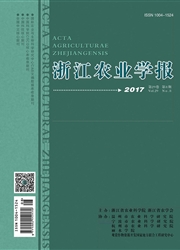

 中文摘要:
中文摘要:
紫色酸性磷酸酶(purple acid phosphatases,PAPs)属于金属磷酸酯酶家族,参与了植物大量的生理反应,特别是磷素的吸收与利用。本研究利用已经发表的辣椒基因组数据,采用同源比对方法对辣椒PAP基因家族进行鉴定与表达分析。通过鉴定发现辣椒基因组中至少含有25个PAP基因成员,氨基酸序列长度在264~639 aa,具有1~12个内含子,不均匀地分布在12条染色体上,仅发现1对基因以串联重复的形式存在。系统发育关系表明,辣椒、拟南芥和水稻PAP基因家族成员可以分为3个家族,8个亚家族,每个家族成员的数目是变异的,而且存在6对直系同源基因和20对旁系同源基因,这表明PAP基因家族的存在早于辣椒、拟南芥和水稻的分化。基于RNA-seq数据库和q RT-PCR方法,对辣椒PAP基因的组织表达及果实发育的不同时期进行分析,结果表明PAP家族基因具有组织表达特异性和发育时期表达特异性。
 英文摘要:
英文摘要:
Purple acid phosphatases( PAPs) are members of the metallo-phosphoesterases involved in a variety of physiological functions,especially phosphate acquisition in plants. In this paper,genome-wide identification and analysis of PAP gene family members in pepper were performed with homologues alignment method. These results found that the whole pepper genome contains at least 25 PAP genes with protein sequence length varying from 264 to 639 aa. Number of introns ranged from 1 to 12. They are distributed unevenly on 12 chromosomes,only had one tan-dem duplication. Phylogenetic relationships showed that PAP genes from three plants species( pepper,Arabidopsis and rice) can be separated into 3 groups,8 subgroups,and the number of each group is variable. Six and twenty pairs of orthologous and homologous genes were found,indicating that the diversity of PAP genes occurred before the split of pepper,Arabidopsis and rice. Based on the RNA-seq database and q RT-PCR method,the expression analysis of different tissues and fruit development stages indicated that these genes had tissue and development stages specificity.
 同期刊论文项目
同期刊论文项目
 同项目期刊论文
同项目期刊论文
 期刊信息
期刊信息
